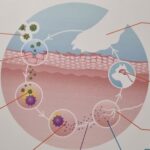Itchy skin can cause absolute chaos and really affect your dog’s quality of life. One of the most common and frustrating ‘itchy skin’ conditions we see in dogs is atopic dermatitis. This inflammatory condition is caused by a reaction to allergens in the environment (a bit like the common triggers of asthma and hay fever in humans). It is particularly troublesome in spring and summer but can occur all year round.
Allergens that might cause a problem include: grasses, trees, plant pollen, dust mites, insects, and moulds. An interesting fact is that most allergens are absorbed through exposed skin rather than breathed in. Many dogs with atopic dermatitis have a defective skin barrier that does not stop these allergens.
The signs associated with atopic dermatitis generally consist of itching, scratching, rubbing, biting, and licking. They usually appear when your dog is between 1 and 6 years of age.
Common sites your dog may be itchy:
– Ears (recurrent ear infections are common)
– The feet and in between the toes
– The armpits
– The groin and anal glands
– Around the eyes
The itching quickly leads to self-trauma of the skin which causes secondary infections that require additional medication.
Diagnosis and management of atopic dermatitis relies on a good history of your dog’s symptoms and a thorough physical examination. It is essential that all potential parasitic causes and food allergies are ruled out.
Most dogs suffering from atopic dermatitis will need medication which will depend on the severity and frequency of flare ups, but other measures such as special washes, diets, and lotions can be very helpful as well. We often get asked about antihistamines in dogs, but don’t find them particularly helpful in managing these problems.
The good news is that there are some exciting new immunotherapy drugs available that have minimal side effects, and can greatly improve your dog’s comfort and quality of life.
Helpful Tips
- avoid long grass
- wiping down the effected areas of skin with a damp cloth after walks especially the under arms, inner legs and belly. Doing this can reduce the build up of allergens in direct skin contact.
- special diets now available can help strengthen up the skin barrier, and reduce histamine release.



